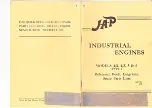
8.7
Section 8
Electrical System and Components
8
Troubleshooting CD Ignition Systems
The CD ignition system is designed to be trouble-free
for the life of the engine. Other than periodically
checking/replacing the spark plug, no maintenance or
timing adjustment is necessary or possible.
Mechanical systems do occasionally fail or break
down, however, so the following troubleshooting
information is provided to help you get to the root of a
reported problem.
Reported ignition problems are most often due to poor
connections. Before beginning the test procedure,
check all external wiring. Be certain all ignition-related
wires are connected, including the spark plug lead. Be
certain all terminal connections fit snugly. Make sure
the ignition switch is in the run position.
NOTE: The CD ignition systems are sensitive to
excessive load on the kill lead. If a customer
complains of hard starting, low power, or
misfire under load, it may be due to excessive
draw on the kill circuit. Disconnect any
auxiliary kill wires or safety switches
connected to the kill circuit and operate the
engine to determine if the reported problem is
gone.
NOTE: The spark advance module (SAM), used with
Smart Spark
™
, requires an external power
source of at least 7.2 volts DC. If you are
installing a replacement battery on a unit that
has an engine with Smart Spark
™
, be certain
the battery is fully charged prior to installation.
Testing of Smart Spark
™
Ignition Systems
on CV16 Engines
The following procedure is provided for troubleshooting
ignition problems on CV16 engines. It will allow you to
pinpoint the failed components.
Special Tools Required:
•
Tester KO1046*
•
Multi-meter (digital)
Specifications Required:
•
Spark plug gap 0.030"
•
Ignition module air gap 0.008-0.012" (0.010")
*NOTE: Ignition tester KO1046 must be used to test
Smart Spark
™
ignition. Use of any other tester
can result in inaccurate findings. Battery on
unit must be fully charged and properly
connected before making any of these tests.
Be sure drive is in neutral and all external
loads are disconnected.
Preliminary Test
To be certain the reported problem is in the engine
ignition system, it should be isolated from the unit,
as follows.
1. Locate the plug connectors where the wiring
harnesses from the engine and unit are joined.
Separate the connectors and remove the white
‘‘kill’’ lead from the engine connector. Rejoin the
connectors, and position or insulate the kill lead
terminal so it cannot touch ground. Try to start the
engine to verify whether the reported problem is
still present.
a. If the problem is gone, the electrical system
on the unit is suspect. Check the key switch,
wires, connections, safety interlocks, etc.
b. If the problem persists, continue with the
following troubleshooting procedure. Leave
the kill lead isolated until all testing is
completed.
Troubleshooting Procedure
1. Disconnect spark plug lead and attach it to tester
KO1046. Attach tester clip to a good ground, not
to the spark plug.
2. Crank the engine and observe tester for spark. Do
not touch tester while cranking.
3. If no spark is observed, verify that spark advance
module (SAM) is getting proper voltage.
a. Return to the connector where the engine
and unit wiring harnesses are joined and find
the double red lead in the back of the engine
connector. Using a DC voltmeter with a
probe lead, test the voltage at the terminal on
the double red lead with the key switch in
both the ‘‘start’’ and ‘‘run’’ positions. At least
7.2 volts must be present. If voltage is low,
proceed to step 4. If voltage is above 7.2,
proceed to step 5.
Summary of Contents for COMMAND CV11
Page 1: ...1 COMMAND SERVICE MANUAL VERTICAL CRANKSHAFT CV11 16 CV460 465 CV490 495...
Page 20: ...2 4 Section 2 Special Tools...
Page 28: ...4 4 Section 4 Air Cleaner and Air Intake System...
Page 54: ...6 6 Section 6 Lubrication System...
Page 109: ...9 15 Section 9 Disassembly 9 Regulating Pin Governor Gear Figure 9 53 Removing Governor Gear...
Page 110: ...9 16 Section 9 Disassembly...
Page 146: ...1 COMMAND SERVICE MANUAL VERTICAL CRANKSHAFT CV11 16 CV460 465 CV490 495...
Page 148: ......
















































